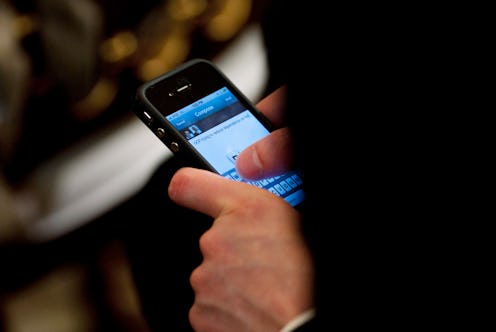News
How To Protect Your Phone From That Text
Maybe it's bad luck, bad karma, or a bad ex, but somehow you received the text that broke the Internet. What do you do if you get the text message that could crash your iPhone? A bug on Apple's iOS application discovered yesterday will cause the Message application on iPhones to crash after a specific string of characters is sent to the device. But is there a way to protect your phone from the text message?
The Guardian reported that the crash appears to be linked to how Apple's iOS system renders non-Latin text, specifically the Arabic text that is contained in the string of characters within the disruptive message. Know how there's an ellipses that abbreviates long iMessages when you look at them in banner view? According to The Guardian, that ellipses wasn't designed to be used with non-Latin script characters such as Arabic and Chinese.
No official fix for the buzzkill of a text has been released by Apple, though several outlets report that a remedy is in the works, and Apple has responded to questions about the fix. An Apple spokesperson told 9 to 5 Mac:
We are aware of an iMessage issue caused by a specific series of unicode characters and we will make a fix available in a software update.
Apple has been quick to fix bugs, so hopefully this one will come soon, though no release date has yet been confirmed. In the meantime, fear not, there are other methods of solving the problem.
The Preventative Method
An ounce of prevention is worth a pound of cure, especially in cases of a cryptic combination of ASCII and unicode text that will disable your iPhone. For those who have yet to receive the disabling text but think you might be at risk (i.e. you have a vindictive ex, scheming co-worker, or 17-year old brother), Ars Technica offers a simple preventative measure: Go to System Settings>Notifications>Messages>Show Previews, and turn it off.
Several Reddit users are speculating whether the crash is due to how the iMessage banners display Unicode, though Apple has not officially disclosed the reason for the bug. One user noted that the message didn't crash the recipient's phone when they had it open to the conversation in iMessages.
The Do-It-At-Your-Own-Risk Methods
Before you proceed with these methods, remember that Apple has yet to release an official fix to the bug but is expected to do so. But if you've received the disabling text and are willing to risk it, users sent 9 to 5 Mac a few of their home-brewed remedies to the text message. One proposed fix is to reply to the disabling iMessage through Siri or your MacBook. Simply open your Macbook, pull up the Messages icon and reply to the offending message through your Macbook. The Guardian reported that sending the string to MacBooks did not trigger a crash when they ran a test.
According to MacRumors, if the offending iMessage was sent while you are still in conversation view (i.e. you are in the middle of texting with the sender) having the person send a reply message can be enough to fix the problem. But if you're in conversation list view, the app could crash when you open the text. MacRumors suggests sending yourself a message through Siri. The International Business Times also suggests sending yourself a picture through the Photos app on your phone as another potential remedy.
Also, are you on less-than-awful terms with the person who sent you the system-disabling text message in the first place? Ask them (whether it's in person, GChat, or Twitter) to send you another text message, thus moving the offending text further down the line of texts shown in the Banner feature, or delete your shared string of iMessages from their phone entirely.
The Wait And See Method
Bar either of these methods, you could always try the third, and least instantly gratifying: Wait for Apple to release an official software update. In the meantime, embrace your diet from texting. After all, there are a myriad of ways that texting is bad for you. The iMessage bug could be a sign that you need a much needed hiatus from this interconnected world we live in.
Images: Getty (3)
